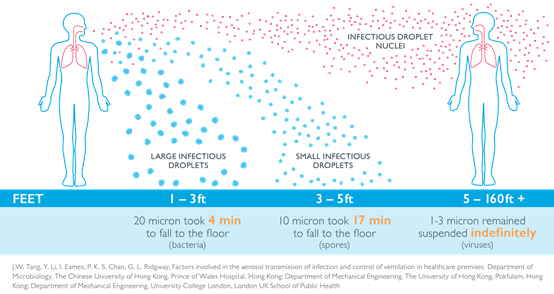
Covid-19 exists in the form of aerosols – What other aerosol pollutants are in the indoor air?
22 December 2022
Can a virus be transmitted by aerosol?
Is the Covid-19 virus transmitted by “aerosol”? Whether the new coronavirus that spread globally in 2019 can be transmitted by aerosol has been controversial. Until 2021, the “Lancet” published a review article, emphasising that there are 10 scientific reasons to support the aerosol transmission (airborne transmission) of the new coronavirus. At almost the same time, the “British Medical Journal” (BMJ) published an editorial, pointing out that Covid-19 ‘redefined aerosol transmission’.

Aerosol (aerosol) refers to the colloid formed by the dispersion and suspension of solid or liquid particles in a gaseous medium, with a size of 0.001-100 microns. Since aerosol particles are larger than gaseous molecules and smaller than dust particles, they do not obey the movement rules of gas molecules, nor do they settle like dust particles. They have the properties of colloids suspended in the air. The diameter of viruses are generally 0.02 microns to 0.25 microns, and most viruses are about 0.1 microns in diameter. The size of the virus is within the definition range of an aerosol, and the virus exists in the form of an aerosol in the air.
There are many aerosols in the air. To facilitate the distinction, solid particles are sometimes called smoke, dust, or dust, liquid particles are called mist, and sometimes aerosols mixed with solid and liquid particles are called smoke. Regardless of the name, the air we come into contact within our daily life is full of aerosol particles, and we are living in aerosols.
According to worldwide surveys, the number one pollutant in indoor air is aerosol pollutants. Aerosol pollution has aroused widespread concern from various related professionals.
According to statistics, the transmission degree of the new coronavirus is higher indoors than outdoors. In indoor air, in addition to virus aerosols, there are many types of aerosols, including dust, smog, smoking smoke, kitchen fumes, lead dust, radon dust, microbial aerosols, pollen, sand (coal) dust storms, aerosols agents and environmental hormones. These pollutants have a serious impact on human health in local areas or in some specific environments, and sometimes form a synergistic effect of multiple aerosol pollutants. Aerosol pollutants in the common indoor air mainly include:
Dust
The majority of us live in urban spaces, aware that as long as a room is not cleaned for a day, it will be full of dust. This is dust visible to the naked eye. In fact, there are many dust particles invisible to the naked eye in the air. We call it an aerosol. Aerosols with a diameter of 0.5-10 microns in aerosols are called inhalable particulate matter, such as PM 2.5. This particle can be suspended in the air for a long time and is easily inhaled by the human body. After being inhaled into the human body, about 50% of it is adsorbed on the lung wall and can penetrate deep into the lung tissue, causing bronchitis and pneumonia, asthma, emphysema, and lung cancer, leading to decreased cardiopulmonary function and even failure.
Indoor dust particles mainly come from the intrusion of atmospheric dust particles, the carrying of people’s clothing, and the dander of people and pets. A large amount of dust has accumulated in the air conditioning system. If it is not cleaned in time, it will become the source of indoor dust particles.
300 kinds of organic substances adsorbed from inhalable particulate matter, many of which are highly carcinogenic, teratogenic, and mutagenic polycyclic aromatic hydrocarbons with oxygen-containing heterocyclic compounds. Respirable particles are often mixed with metals, metal compounds and radioactive substances, such as lead dust, mercury dust, radon dust, etc. After these substances invade the lung tissue, they can cause various metal poisoning or radioactive pollution diseases. Inhalable particulate matter may also adsorb acidic oxides in the air and form acid mist under the action of water. After the aerosol is inhaled into the lungs, the toxicity is multiplied, causing pulmonary edema, hardening of the lungs, and even death.
It’s important for our health that we clean frequently, and the windows should be clean and spotless. Most of the dust on the surface of the object is settled from the air. If it is not cleaned in time, it will return to the air due to external force. More suspended particles invisible to the naked eye in the air can only be removed by air purifiers.
Haze
While we might often think of Charles Dickens depiction of a foggy London, in many cases, Chongqing, the smog capital of China, is also famous all over the world. The long fog has always been a kind of poetic and picturesque in people’s memory. For a long time, people still choose morning fog for exercise. Since fog was associated with haze, haze has become a kind of air killer.
Smog is a typical aerosol pollutant. The fine powder-like aerosols in the smog carry pollutants such as dust, sulfuric acid, nitric acid, hydrocarbons and bacteria, which can directly enter the bronchi and even the lungs through the respiratory system. Therefore, the greatest impact of smog is on the human respiratory system, and the diseases caused are mainly concentrated in respiratory diseases, cerebrovascular diseases, nasal cavity inflammation and other diseases. At the same time, in smoggy weather, the air pressure decreases, the inhalable particulate matter in the air increases sharply, the air mobility is poor, and the diffusion speed of harmful bacteria and viruses slows down, resulting in an increase in the concentration of pathogenic microorganisms in the air and a high risk of disease transmission.
In December 1952, the heavy fog in London, England, lasted for four days. A high-risk pollution layer was formed at a low altitude of 100 meters. The smell of “rotten eggs” claimed the lives of 4,700 people within a few days.
This is the famous London smog incident recorded in the history of world environmental protection, which has alerted the world to the smog. Now, London smog and North China smog, which are extreme pollution phenomena, no longer exist yet local smog still exists due to climate and other reasons.
When smog is present it’s important to (especially the rooms where the elderly, the sick, the disabled and other vulnerable people live) close the doors and windows and turn on the air purifier to minimize the impact of the smog on the room.
Cigarette and other smoke
Smoking is another important source of indoor aerosol pollution, and smoking mainly produces fine particles below 1 µm. The world’s authoritative magazine “British Medicine” reported that in the future, among all the causes of death, 1/3 of men will die from smoking-related diseases, and the number of deaths due to smoking will reach 2 million to 3 million every year.
Cigarette smoke contains more than 3,000 chemical components, among which benzopyrene and nitrosamines contained in tobacco tar are strong carcinogens that exist in the form of aerosols. According to clinical observation and experimental results, in addition to causing lung cancer, smoking can also induce oral cancer, pancreatic cancer, gastric cancer, cervical cancer and bladder cancer. Smoking causes 95% of lung cancer deaths, 25% of cardiovascular and cerebrovascular diseases, and 75% of chronic respiratory diseases.
Studies have shown that the number of toxic substances inhaled by passive smoking is several to dozens of times higher than that of mainstream smokers. Toxic substances in second-hand smoke can invade the lungs and vital organs of the body, damage arterial wall cells, promote atherosclerosis, and can cause lung cancer, brain cancer, thyroid cancer, stomach cancer, breast cancer, and cervical cancer. Frequent exposure to second-hand smoke increases the risk of cancer by 2.8 times, and the risk of dying from heart disease is as high as 170% compared to those who stay away from smokers. In view of the dangers of passive smoking, the World Health Organization passed a resolution stating that non-smokers have the right to maintain their health against passive, forced or involuntary smoking violations, and their health should be protected from such violations. hazards caused by environmental pollution.
Therefore, in order to protect the health of non-smokers, to limit or prohibit indoor smoking many countries have formulated laws or regulations prohibiting smoking in public places, public transportation and workplaces. The degree of indifference to smoking and passive smoking depends largely on the lack of awareness of the severity of aerosol pollution produced by smoking. Therefore, it is necessary to vigorously promote the importance of controlling aerosol pollution caused by smoking, sand (coal) dust storms, smog, nuclear leaks, etc, and recommend high-quality air purifiers and other products to the public to prevent the impact of aerosols on health.
Kitchen fumes
Fumes from kitchens in hotels, restaurants, restaurants, canteens, and families have a great impact on the environment and the human body. The Hong Kong Environmental Agency has detected the same pollutants as kitchen fumes in the atmosphere and believes that kitchen fumes are the most important air pollutants after urban vehicle exhaust. Kitchen fume has become a public hazard.
The components of kitchen fumes are complex, and a large amount of organic substances such as acrolein, 3, 4- benzopyrene and cycloaromatic hydrocarbons exist in the state of aerosols, which directly cause mutagenic, teratogenic and carcinogenic effects on relevant kitchen personnel. The survey confirmed that the incidence of lung cancer among cooks is higher than that of other general occupations. It has been reported that there is a clear correlation between kitchen fume and the incidence of lung cancer in women. According to statistics, among non-smoking female lung cancer risk factors, more than 60% of women have been exposed to kitchen fumes for a long time. Worldwide, most lung cancer cases among Asian women are associated with chronic exposure to kitchen fumes.
At present, most of the range hoods sold on the market are made of the principle of cyclone inertia. The purification efficiency of the oil fume in the aerosol state is not high. At the same time, attention has also been paid to the phenomenon of aerosol pollution from range hoods in household kitchens.
Microbial aerosol
Most of the microorganisms in the air, including viruses, attach to aerosols, which are called bioaerosols. Because of its biological nature, it is more harmful than ordinary aerosols.
Under certain conditions, microorganisms have the ability to grow, reproduce, and continue the entire biological process. Microorganisms are like living granular substances. As long as there are appropriate conditions, they will form large biological groups and reflect their biological characteristics. Many pathogenic microorganisms, called pathogens, exist indoors and outdoors, which can cause typhoid, dysentery, cholera, hepatitis and other diseases. Its biological pathogenicity is the biggest characteristic of microbial pollution.
The SARS in 2003, the subsequent avian influenza, influenza A , mouth-foot-foot disease, etc., as well as the infectious diseases and epidemics caused by the new coronavirus and its variants that are still raging in some areas, are all caused by microbial aerosols.
Microbial aerosols in indoor environments are pollutants that cannot be ignored. Microbial aerosols in indoor environments mainly come from human activities. A sneeze can spread 15,000 cold factors. It is useless to wear a mask if you are more than 1 meter away from a tuberculosis patient. Often in modern office swith good airtightness, as long as one person catches a cold, many other people will be infected. Living rooms, no matter how clean they look on the surface, is actually full of mites and other microorganisms dormant everywhere. The dander of people and pets feeds them, and once there is an opportunity, they will come out to make troubles and induce allergic diseases such as asthma, rhinitis, and dermatitis. Household pets can transmit a zoonotic microorganism. When people are close to small animals, they should also be alert to diseases that may be transmitted by pathogenic microorganisms carried by pets.
Mildew in the home kitchen and bathroom should not be underestimated. Mold is a type of fungus. If the human body is infected with fungi, the consequences can be serious.
Kindergartens are places where children are concentrated, and children are vulnerable groups who are prone to contract diseases due to aerosol pollution.
Whether it is an office, a living room, or a kindergarten, how can we actually prevent microbial aerosols from spreading diseases? The World Health Organization believes that the concentration of bacteria in the air is an important indicator of air hygiene. If the total number of microbial aerosols in the air exceeds 700cfu/m 3 , it is easy to infect diseases. If it is less than 500fu/m 3 , the infection will be reduced. If it is less than 200fu /m 3 , the infection hardly occurs.
Pollen
Pollen is also a microbial aerosol. At present, cities carry out many greening and tree planting activities to improve the ecological environment, but the negative effect is that pollen pollution has become a new public hazard. Pine, cypress, fir, poplar, birch, beech, and oak, which are widely used in urban greening, have become the main pollution sources of urban pollen. Pollen has caused tens of millions of hay fever patients and has even become a serious social problem.
It is said that in the 1960s, almost no one in Japan had hay fever symptoms, and it was not an epidemic or frequently-occurring disease in North America, Europe, and Australia. But then, the number of people suffering from hay fever increased rapidly. Up to now, about 10% of Japan ‘s population, or 12 million people, suffer from the disease. The proportion is even higher in Australia and Europe. The number of hay fever patients in the United States has been on the rise in a straight line in the past 10 years. Some people in Japan and Australia call hay fever the ” national disease ” .
Another important reason why pollen has become a public nuisance is that the number of people suffering from hay fever has increased sharply, that is, the number of people suffering from allergies has continued to increase. In cities, the airtight performance of modern buildings is getting better and better, poor ventilation and indoor air pollution have become the background for the increase of people with allergies. Surveys of children showed that 70% –80% of children who tested positive for the indoor allergen tick also tested positive for pollen. Children who tested negative for ticks decreased to 30 percent positive for pollen. Children living in urban residential areas and near roads had a higher rate of being pollen-positive than children living in rural areas and pastoral suburbs.
Pollen is easily inhaled through the nose and reaches deep into the lungs, potentially causing allergic diseases such as hay fever and respiratory diseases such as asthma.
Pollen allergy is a common and frequently occurring disease that seriously endangers human health. Hay fever sufferers range from young people in their teens to the elderly over 60 years old. Hay fever is rarely inherited. In most cases, due to long-term inhalation of chemical pollutants such as automobile exhaust and industrial waste gas, these chemical pollutants gradually accumulate in the body, and hay fever is suddenly discovered at a certain age. Once you suffer from severe hay fever, you will get sick every year in a certain season.
Some people who are engaged in white-collar work have the least ability to resist the comprehensive pollution of urban air pollution and pollen. In addition, people may also suffer from hay fever after changes in the work, study environment and living environment.
The research results of modern environmental science show that in addition to the influence of pollen monomers on the cause of hay fever, the comprehensive effect of urban air pollutants on the human body cannot be ignored. The air pollutants that constitute this comprehensive effect mainly include nitrogen oxides, sulfur dioxide, photochemical peroxides, inhalable particulate matter and other chemicals produced by automobile and industrial exhaust gases.
There is no standard to indicate how high the concentration of pollen in the indoor air is safe. Only by eliminating the pollen in the indoor air can hay fever patients really get rid of the sea of suffering.
Lead dust
Lead is a heavy metal element with neurotoxicity. The human body has almost no ability to discharge lead poisoning, and more than 60 % of the lead dust inhaled into the human body will remain permanently in the body. Lead prevents the production of hemoglobin in the human body through various ways. The blood lead level of the human body is directly related to the exposure to the air environment with lead dust. The ideal blood lead content in the human body should be zero.
Urban air contains a large amount of heavy metal pollutants. The harm caused by the pollution of lead and its compounds to people, especially children, has attracted extensive attention. Lead as a central nervous system poison has irreversible damage to children’s psychological, intellectual, and behavioral development, making the prevention and research of lead damage an important topic in pediatrics and child health care.
Lead and its compounds exist in the air in the form of aerosols, often mixed with dust particles, known as lead dust. Lead dust can be seen everywhere, heavier than air, and the concentration of lead dust in the air below 1 meter from the ground is higher. The distance between 75-100cm from the ground is just the breathing zone of children. In addition, children have a large demand for oxygen, and the absorption rate of lead in children’s respiratory tract is higher than that of adults, which is 1.6-2.7 times that of adults. Therefore, children inhaled from the respiratory tract Lead is more than adults.
Unqualified leaded gasoline used by motor vehicles, industrial waste gas and weathering of leaded paint are the main reasons why the content of lead dust in the air exceeds the standard. In recent years, the use of unleaded gasoline has been promoted internationally, and the total amount of lead dust emissions in industrial waste gas in large cities has been strictly controlled, and the concentration of newly added lead dust may be greatly reduced. However, a large amount of lead has accumulated in the natural environment all the year round, and the soil has become the largest reservoir of lead in nature. Lead element has become one of the chemical components of the earth’s crust. Lead in soil and dust has a cumulative effect on the environment, and the impact is relatively long-term. It will increase again under natural or artificial conditions and re-disperse in the air.
Some shocking reports make people restless. The survey reports on the concentration of lead dust in the air of some industrial cities and the blood lead concentration of children show that the pollution of lead dust has reached a level that cannot be ignored.
Now we know that although blood lead is preventable and treatable. However, the intellectual impairment caused by lead poisoning in children is irreversible.
Indoor lead dust is one of the important sources of lead exposure for children. The content of indoor lead dust has a very obvious correlation with children’s blood lead levels and controlling indoor lead dust can effectively reduce children’s lead levels.
People of insight exclaimed: the prevention and treatment of lead poisoning in children is a test of the power of society, parents and people’s livelihood.
Radon dust
Radon (Re) is the only natural radioactive noble gas in nature, which is formed by the decay of radium. Radon exists in the air as an aerosol and is often mixed with dust particles to form radon daughters, or radon dust. This radon dust, which exists in the form of aerosol, is easily inhaled into the human body, and trapped in the respiratory system. Radon can accumulate locally in the respiratory system and induce lung cancer. The latent period of its induction of lung cancer is mostly more than 15 years. 20 % of lung cancer patients in the world are related to radon dust pollution. Some people call radon dust and smoking the two major killers of lung cancer. The World Health Organization lists radon dust as one of the 19 carcinogens.
Radon is widely distributed in nature and may exist around you. Excess radon has been detected in almost 20 % of residential buildings in the United States. Radon dust is radioactive, and its radiation effect may cause great harm to the human body. Scientific research shows that the radon radiation that people may suffer in their lifetime is about twice as much as other radiation effects that they may suffer. In the United States and some other countries, there are even cases of discoloration caused by radon.
It has been found that some natural stones used as building materials, such as granite, tiles, cement, gypsum, etc., carry radioactive elements and easily release radon. In 1982, the United Nations Scientific Committee on the Effects of Atomic Radiation made a special report on this. In the atmosphere, the concentration of radon is extremely low and does not pose a threat to human health. However, once it enters the room, if the ventilation is poor, it may accumulate in large quantities, exceeding the allowable concentration. The highest concentration of radon in indoor air is 300 Bq / m3, or 300Bq /m 3.
Aerosol
Aerosols are often used in modern families, but it is unknown that aerosols can also form aerosol pollution. Improper use may affect human health and even bring danger.
Aerosol means that the medicine, emulsion or suspension and a suitable propellant are packaged together in a pressure-resistant container with a special valve system. Inhaled in the lungs or sprayed directly to the mucous membrane of the cavity, skin, and space for disinfection. There are also aerosols that are heated to form smoke.
Aerosols commonly used in households include insecticides, disinfectants, air fresheners, and hair styling mousses.
Aerosol forms an aerosol state in the air. Some experts believe that any aerosol has an impact on the human body, not to mention that the aerosols used for insecticide and disinfection all contain a certain dose of toxic chemicals.
When these aerosols with trace toxicity are absorbed into the human body from the mouth, nose, and skin, and reach various parts of the body through the blood, people with sensitive constitutions are prone to headaches, sneezing, tearing, dizziness, and chest tightness, especially those with asthma Special populations with allergic diseases, such as allergic diseases, may cause allergic reactions, and even affect the respiratory system, endangering life!
When operating the aerosol, wear a mask and try not to let the aerosol touch the skin, mouth, and nose. After using the aerosol, it is necessary to ventilate in time, and it is confirmed that the aerosol has no harmful effect on the human body before entering the room.
Some air cleaners, fragrances, and deodorants also use the aerosol principle to purify indoor air. Although most of these preparations are plant-based and non-toxic, they can carry air pollutants after forming aerosols., Inhalation of the human body will also affect health, so it is recommended that this type of aerosol should not be used in the presence of people, especially to avoid children and people with sensitive constitutions.
Environmental hormones
Some chemical substances are mixed into food and air through various channels, and then enter the human respiratory tract and digestive tract, interfering with human endocrine, and cause endocrine disorders. Scientists collectively refer to this kind of chemical substances that can play a role like hormones as “environmental hormones”. “Environmental hormones” “combine” with normal hormones in the human body, causing endocrine disorders, resulting in abnormal human hormones, which are manifested in many aspects such as development, reproduction, spirit, and emotional wellbeing. Environmental hormones can cause precocious puberty in women, menstrual disorders, endometrial hyperplasia, decreased sperm count in men’s semen, and increased male infertility.
According to preliminary scientific research, at least 300 kinds of harmful substances that play a role similar to hormones in social life to humans and animals have been discovered. Among them, the seven most dangerous ones are mostly used to make paints, laundry detergents, resins, plasticizers, etc. that people use every day. Dioxins and other substances that may be produced by waste incineration are also environmental hormones, which affect the environment and human health.
To sum up, rather than saying that we live in aerosols, it is better to say that we live in polluted aerosols. Air pollution is estimated to cause approximately 2 million premature deaths worldwide each year. In order to prevent damage to health, the World Health Organization proposed a new standard that the annual average concentration of PM 2.5 inhalable particulate matter in the air should be lower than 5 μg/m 3. The World Health Organization believes the new standards suggest that reducing levels of fine particles could cut annual deaths in polluted cities by 15%.

Emission reduction of the main air pollutants by Member State from 2005 to 2020
Indoor air is generally considered to be worse than outdoor air. Due to the extensive use of air conditioners, modern buildings are getting better and better sealed, and pollutants in the indoor air cannot be diffused. Air pollutants inevitably invade indoors through the gaps in buildings and people’s habitual opening of windows. We suffer from both indoor and outdoor pollution, and it is difficult to find a place where we can breathe freely in modern cities.
We need to master the knowledge of these aerosol pollution, and never let aerosol pollution, especially the deeply harmful new coronavirus aerosol that is still present across the world, have a greater effect than it already has.
Latest News

Oxford based air purification experts Healthy Air Technology Ltd recognised at CIBSE Building Performance Awards
News release: Oxford based air purification experts Healthy Air Technology Ltd recognised at CIBSE Building Performance Awards The…

Cloud seeding and air pollution
Recent poor air quality in regions such as Pakistan, China and the UAE has led to the use…

Are scented candles dangerous to indoor air quality?
Recent news articles questioning if scented candles are dangerous to indoor air quality have helped to highlight the…

